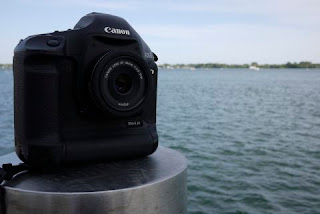
I had an opportunity to play around a little with the new Canon PowerShot G1 X earlier this week. Getting quite a bit of hype since its announcement due to increase in popularity of semi-pro compacts and mirrorless alike, I decided to take a quick glance at it.

The camera is noticeably bigger than the (now) old G12, although, when put side to side, it isn't that much bigger, making the G1 X still a fairly portable camera. Even being a bigger camera than the Fuji X10 is easily forgivable due to the huge increase in the sensor size of the G1 X (just 20% smaller than the APS-C type sensor). Being a bigger camera, it allows G1 X to have a 3" Screen (as opposed to the 2.8" of the G12), but what's more important was the quality of the screen has also been improved, providing a more detailed and fine visuals.

The G1 X definitely has a few good points. What really shines with this camera has to be the surprisingly good ISO performance. The following are the ISO-labeled photos for comparison purposes. Please forgive the lack of composition, among many things.




It is also worth noting the G1 X comes with a lens cap. Millions are affected each year with lens cap loss, so this might be an issue to some, however, the lens cap for the G1 X looks reliable and even comes with a lens-keeper-string. With proper installation, one should not have to fear losing this lens cap. Lens cap designs and quality may seem insignificant at first, and it doesn't affect the image quality of the camera in anyway, but sometimes it's the little things that matter more. Canon definitely deserves some points for this one.

Having said that, Not all is perfect with the all-in-one-semi-professional-G1-X. To start
the bashing, the rugged (and somewhat matte) finish the G12 had is no more. The G1 X has a cheap exterior finish, which one would expect on a Canon ELPH compact series. It's disappointing to see Canon has continued on their path of reducing the build quality of their Canon PowerShot G## by the generation. An asking price of $800.00 with this hideous level of finish, which also forces it to be a smudge+finger print magnet, just might be too steep for some, but this being a new camera, it just might drop to a more affordable price as time goes on.
An annoying thing one might come across while using the G1 X when one challenges the odd minimum focusing distance. The shortest being 20cm with "macro" mode, and 40cm on normal, this might remind any ex-rangefinder users of this nostalgic feeling, but it sure wont be an welcoming one. Rangefinders typically have 70cm as their minimum focusing distance, so it could be worse, but even the Canon S100 and pretty much all Canon PowerShot cameras at this generation have better minimum focusing distance than this. Of course, a FA-DC58C macro filter adapter can be purchased, but it'll also come with a bad taste in your mouth if you ever need to purchase one. And for some reason, many features including Colour Accent, Colour Swap, (Digital) Fish-eye, Miniature, and other "fun mode" features are nowhere to be found on the G1 X. It's pretty clear Canon intended G1 X users to be "serious" with their photography. I am not going to lose sleep over those features, but I just don't understand why it's not there. Every other Canon PowerShots have them.

It's supposed to read, "Minimum Focusing Distance
Sucks".
Moving on to the optical viewfinder I can say not much has changed, or more accurately, nothing's changed. Viewfinder zooms in or out like the lens does but, it is still mediocre quality like the previous G12. I can see myself using the viewfinder most of the time since I am somewhat patriotic in regards to viewfinders, but for some reason, I can't bring myself to ask for a better one. Not sure why, maybe I just accepted this is as good as it's going to be for a while. Besides, even the famous Fuji X10 doesn't exactly offer a better viewfinder.

Canon had all the tools and experience to make G1 X a one ground-breaking-possibly-mirrorless-killing-monster-camera. While it excels in what it is good at, it makes it hard to truly appreciate G1 X's good points over the many drawbacks that it might annoy you with.





























